Change Management: External Agent, Diagnosis & Feedback in Change
VerifiedAdded on 2023/04/07
|15
|3334
|386
Report
AI Summary
This report examines the change management process within a large organization, focusing on the advantages of using an external change agent when management and employees have differing views on existing problems. It identifies 'Identifying and Managing Barriers to a Change Process' as a critical problem stage, highlighting the importance of objectivity and incautiousness in addressing internal power structures. The report emphasizes the role of diagnosis and feedback at various stages of the change process, explaining how diagnosis helps identify deviations from set goals and objectives, while feedback provides data for informed decision-making. It also discusses five key activities in planning and implementing change based on the Action Research Model, including problem identification, consultation with an OD consultant, joint diagnosis, joint action planning, and feedback to key groups, using real-world examples to demonstrate effective implementation.
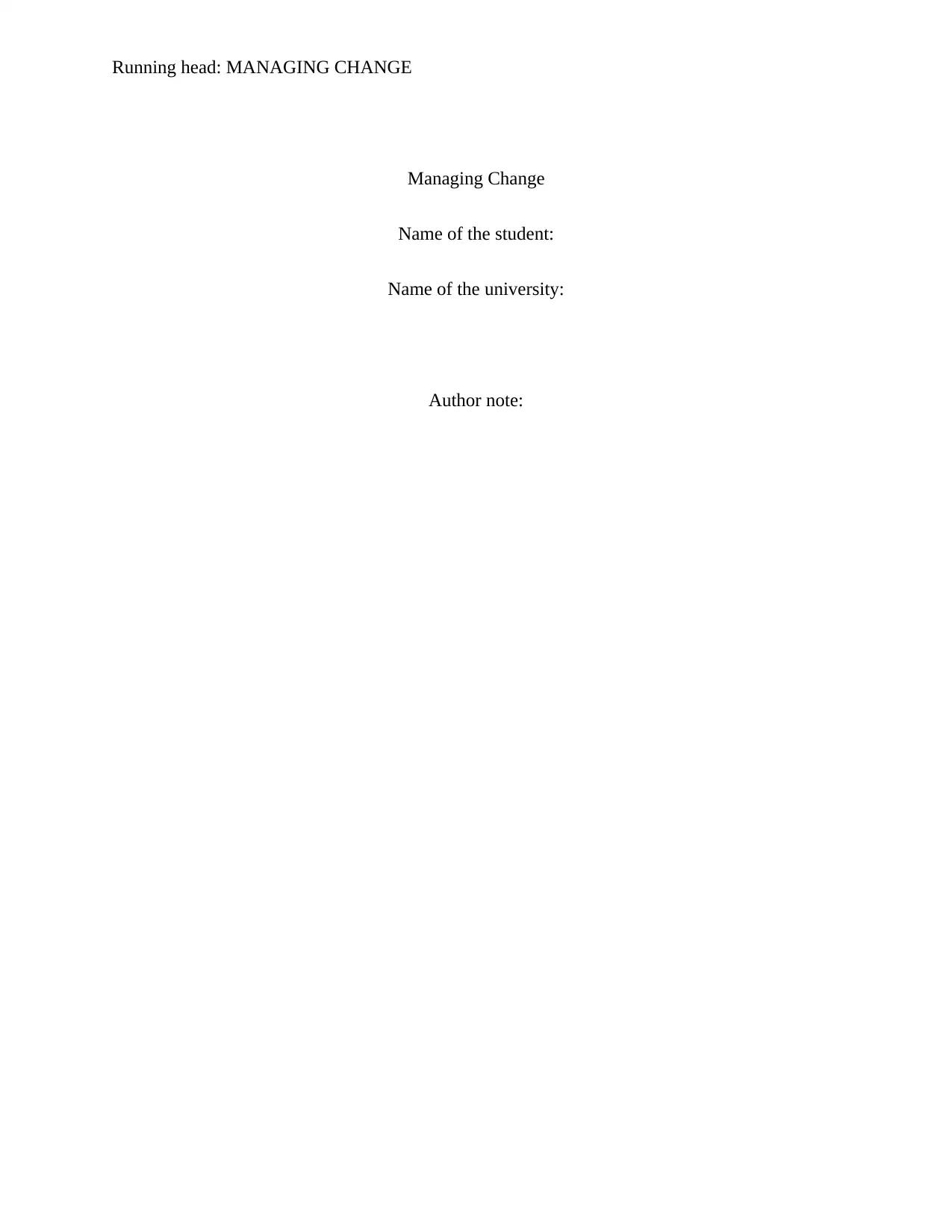
Running head: MANAGING CHANGE
Managing Change
Name of the student:
Name of the university:
Author note:
Managing Change
Name of the student:
Name of the university:
Author note:
Paraphrase This Document
Need a fresh take? Get an instant paraphrase of this document with our AI Paraphraser
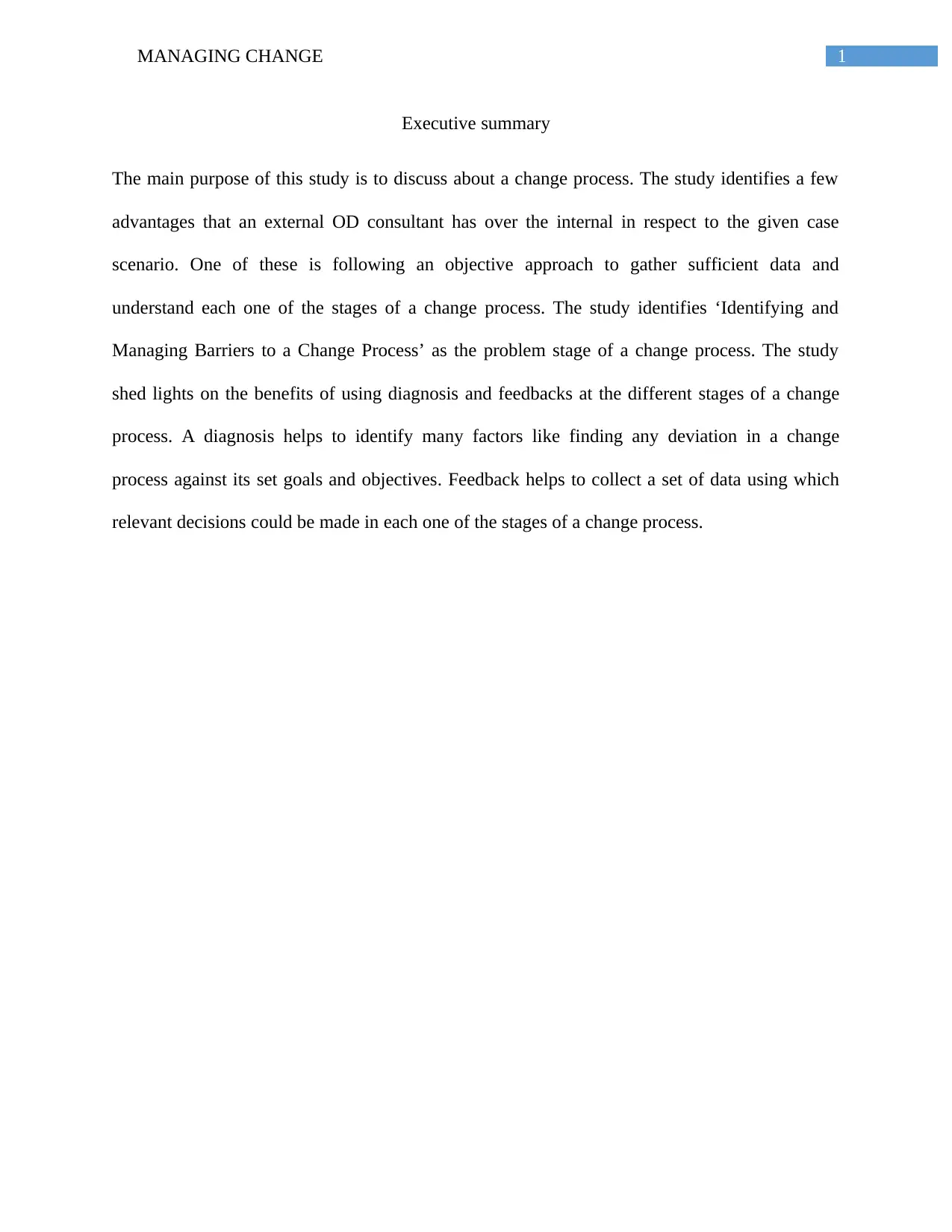
1MANAGING CHANGE
Executive summary
The main purpose of this study is to discuss about a change process. The study identifies a few
advantages that an external OD consultant has over the internal in respect to the given case
scenario. One of these is following an objective approach to gather sufficient data and
understand each one of the stages of a change process. The study identifies ‘Identifying and
Managing Barriers to a Change Process’ as the problem stage of a change process. The study
shed lights on the benefits of using diagnosis and feedbacks at the different stages of a change
process. A diagnosis helps to identify many factors like finding any deviation in a change
process against its set goals and objectives. Feedback helps to collect a set of data using which
relevant decisions could be made in each one of the stages of a change process.
Executive summary
The main purpose of this study is to discuss about a change process. The study identifies a few
advantages that an external OD consultant has over the internal in respect to the given case
scenario. One of these is following an objective approach to gather sufficient data and
understand each one of the stages of a change process. The study identifies ‘Identifying and
Managing Barriers to a Change Process’ as the problem stage of a change process. The study
shed lights on the benefits of using diagnosis and feedbacks at the different stages of a change
process. A diagnosis helps to identify many factors like finding any deviation in a change
process against its set goals and objectives. Feedback helps to collect a set of data using which
relevant decisions could be made in each one of the stages of a change process.
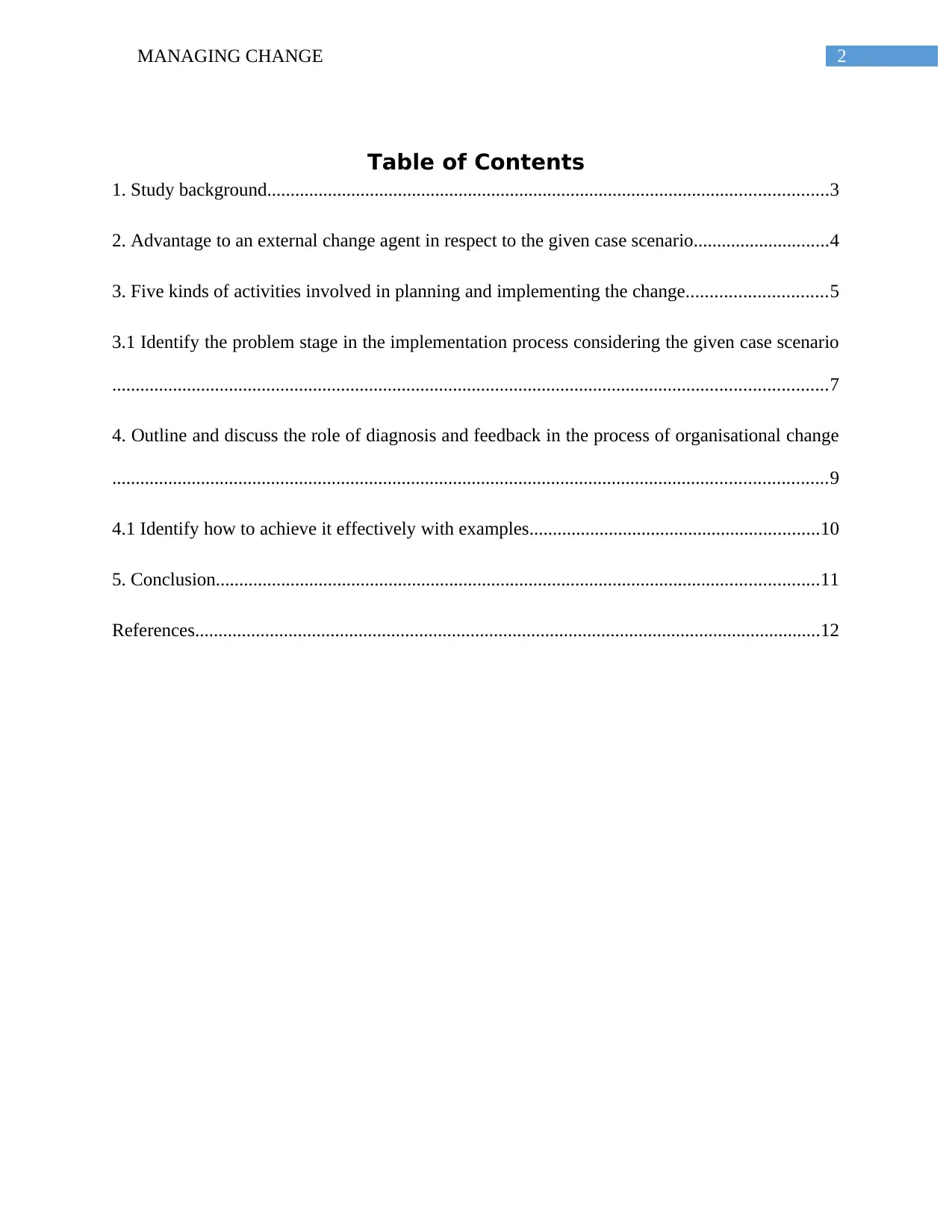
2MANAGING CHANGE
Table of Contents
1. Study background........................................................................................................................3
2. Advantage to an external change agent in respect to the given case scenario.............................4
3. Five kinds of activities involved in planning and implementing the change..............................5
3.1 Identify the problem stage in the implementation process considering the given case scenario
.........................................................................................................................................................7
4. Outline and discuss the role of diagnosis and feedback in the process of organisational change
.........................................................................................................................................................9
4.1 Identify how to achieve it effectively with examples..............................................................10
5. Conclusion.................................................................................................................................11
References......................................................................................................................................12
Table of Contents
1. Study background........................................................................................................................3
2. Advantage to an external change agent in respect to the given case scenario.............................4
3. Five kinds of activities involved in planning and implementing the change..............................5
3.1 Identify the problem stage in the implementation process considering the given case scenario
.........................................................................................................................................................7
4. Outline and discuss the role of diagnosis and feedback in the process of organisational change
.........................................................................................................................................................9
4.1 Identify how to achieve it effectively with examples..............................................................10
5. Conclusion.................................................................................................................................11
References......................................................................................................................................12
⊘ This is a preview!⊘
Do you want full access?
Subscribe today to unlock all pages.

Trusted by 1+ million students worldwide
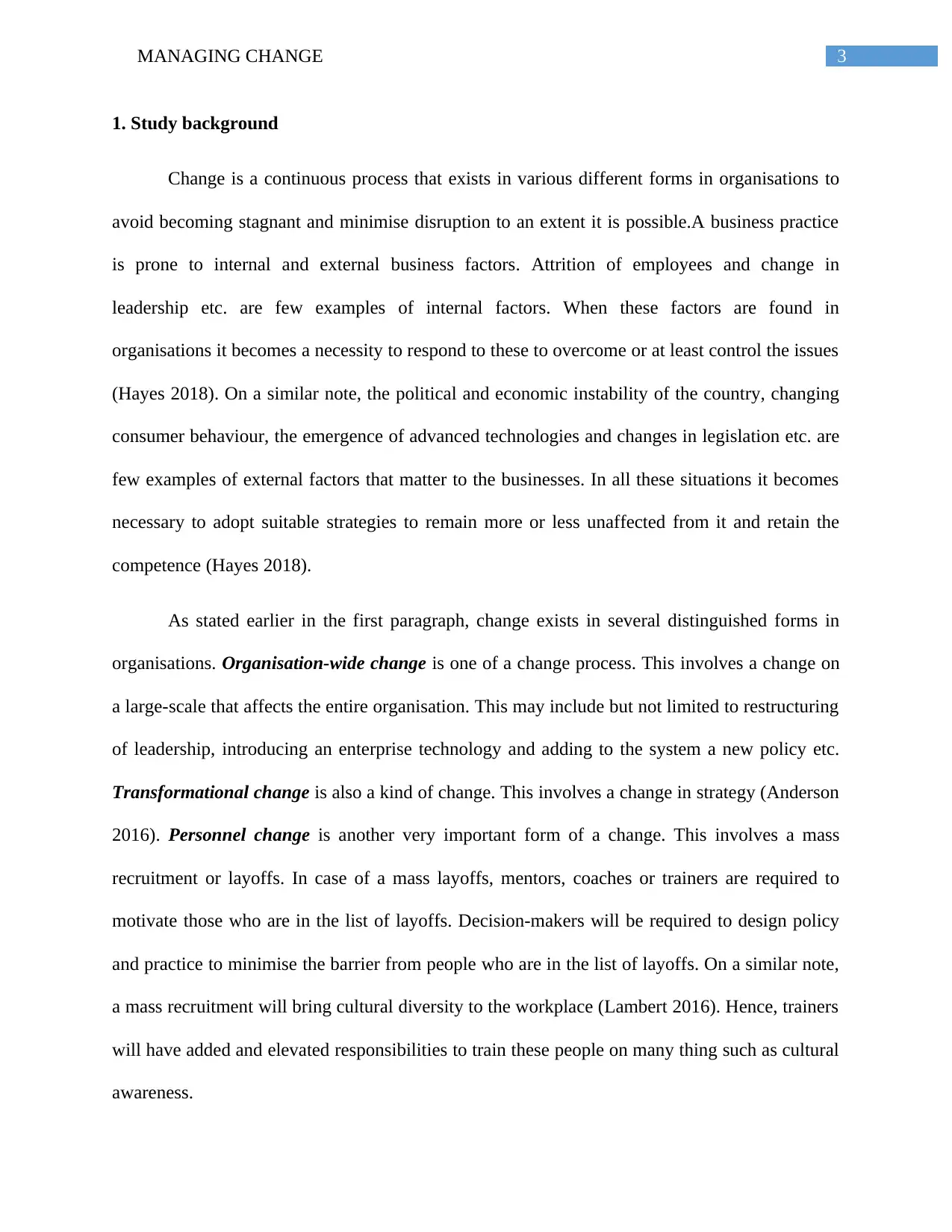
3MANAGING CHANGE
1. Study background
Change is a continuous process that exists in various different forms in organisations to
avoid becoming stagnant and minimise disruption to an extent it is possible.A business practice
is prone to internal and external business factors. Attrition of employees and change in
leadership etc. are few examples of internal factors. When these factors are found in
organisations it becomes a necessity to respond to these to overcome or at least control the issues
(Hayes 2018). On a similar note, the political and economic instability of the country, changing
consumer behaviour, the emergence of advanced technologies and changes in legislation etc. are
few examples of external factors that matter to the businesses. In all these situations it becomes
necessary to adopt suitable strategies to remain more or less unaffected from it and retain the
competence (Hayes 2018).
As stated earlier in the first paragraph, change exists in several distinguished forms in
organisations. Organisation-wide change is one of a change process. This involves a change on
a large-scale that affects the entire organisation. This may include but not limited to restructuring
of leadership, introducing an enterprise technology and adding to the system a new policy etc.
Transformational change is also a kind of change. This involves a change in strategy (Anderson
2016). Personnel change is another very important form of a change. This involves a mass
recruitment or layoffs. In case of a mass layoffs, mentors, coaches or trainers are required to
motivate those who are in the list of layoffs. Decision-makers will be required to design policy
and practice to minimise the barrier from people who are in the list of layoffs. On a similar note,
a mass recruitment will bring cultural diversity to the workplace (Lambert 2016). Hence, trainers
will have added and elevated responsibilities to train these people on many thing such as cultural
awareness.
1. Study background
Change is a continuous process that exists in various different forms in organisations to
avoid becoming stagnant and minimise disruption to an extent it is possible.A business practice
is prone to internal and external business factors. Attrition of employees and change in
leadership etc. are few examples of internal factors. When these factors are found in
organisations it becomes a necessity to respond to these to overcome or at least control the issues
(Hayes 2018). On a similar note, the political and economic instability of the country, changing
consumer behaviour, the emergence of advanced technologies and changes in legislation etc. are
few examples of external factors that matter to the businesses. In all these situations it becomes
necessary to adopt suitable strategies to remain more or less unaffected from it and retain the
competence (Hayes 2018).
As stated earlier in the first paragraph, change exists in several distinguished forms in
organisations. Organisation-wide change is one of a change process. This involves a change on
a large-scale that affects the entire organisation. This may include but not limited to restructuring
of leadership, introducing an enterprise technology and adding to the system a new policy etc.
Transformational change is also a kind of change. This involves a change in strategy (Anderson
2016). Personnel change is another very important form of a change. This involves a mass
recruitment or layoffs. In case of a mass layoffs, mentors, coaches or trainers are required to
motivate those who are in the list of layoffs. Decision-makers will be required to design policy
and practice to minimise the barrier from people who are in the list of layoffs. On a similar note,
a mass recruitment will bring cultural diversity to the workplace (Lambert 2016). Hence, trainers
will have added and elevated responsibilities to train these people on many thing such as cultural
awareness.
Paraphrase This Document
Need a fresh take? Get an instant paraphrase of this document with our AI Paraphraser
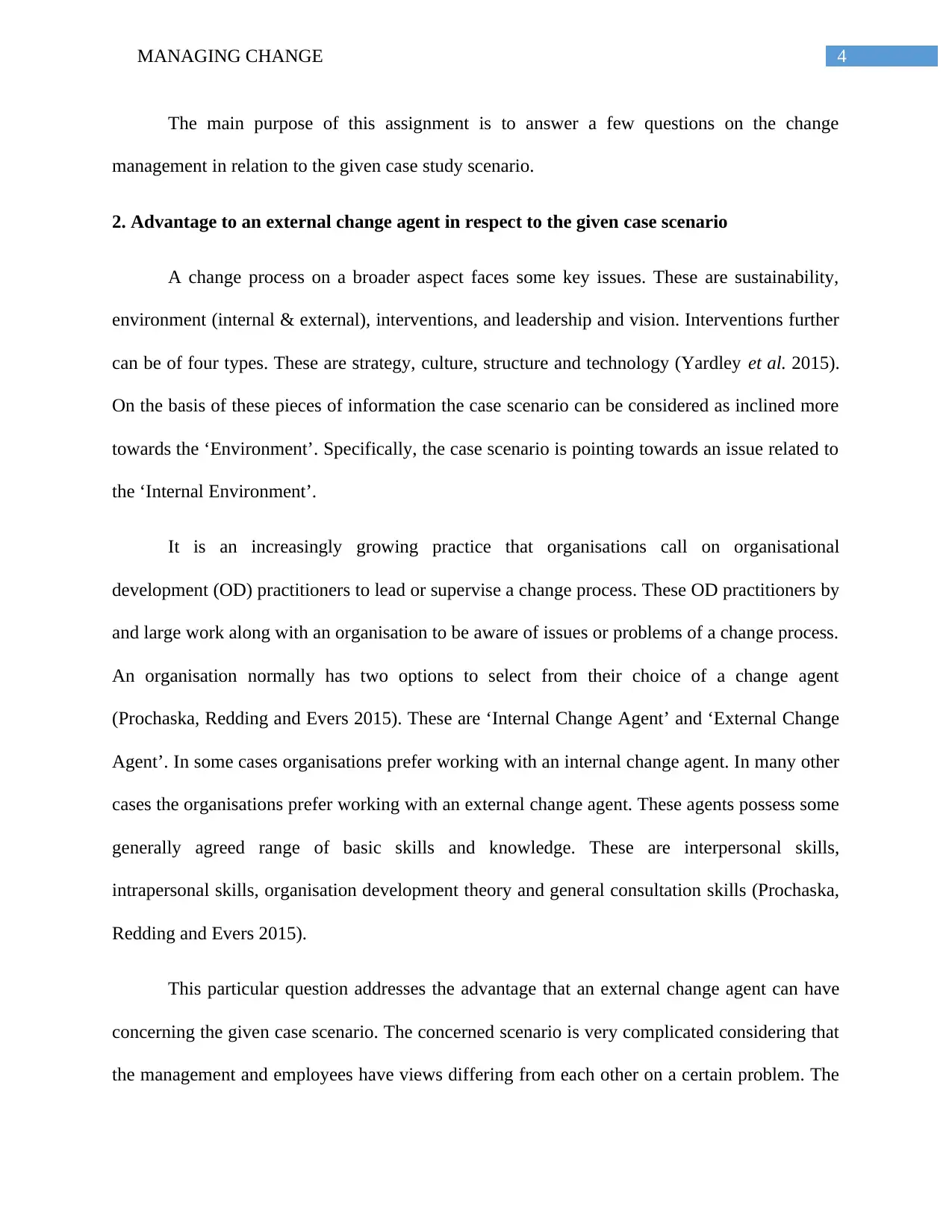
4MANAGING CHANGE
The main purpose of this assignment is to answer a few questions on the change
management in relation to the given case study scenario.
2. Advantage to an external change agent in respect to the given case scenario
A change process on a broader aspect faces some key issues. These are sustainability,
environment (internal & external), interventions, and leadership and vision. Interventions further
can be of four types. These are strategy, culture, structure and technology (Yardley et al. 2015).
On the basis of these pieces of information the case scenario can be considered as inclined more
towards the ‘Environment’. Specifically, the case scenario is pointing towards an issue related to
the ‘Internal Environment’.
It is an increasingly growing practice that organisations call on organisational
development (OD) practitioners to lead or supervise a change process. These OD practitioners by
and large work along with an organisation to be aware of issues or problems of a change process.
An organisation normally has two options to select from their choice of a change agent
(Prochaska, Redding and Evers 2015). These are ‘Internal Change Agent’ and ‘External Change
Agent’. In some cases organisations prefer working with an internal change agent. In many other
cases the organisations prefer working with an external change agent. These agents possess some
generally agreed range of basic skills and knowledge. These are interpersonal skills,
intrapersonal skills, organisation development theory and general consultation skills (Prochaska,
Redding and Evers 2015).
This particular question addresses the advantage that an external change agent can have
concerning the given case scenario. The concerned scenario is very complicated considering that
the management and employees have views differing from each other on a certain problem. The
The main purpose of this assignment is to answer a few questions on the change
management in relation to the given case study scenario.
2. Advantage to an external change agent in respect to the given case scenario
A change process on a broader aspect faces some key issues. These are sustainability,
environment (internal & external), interventions, and leadership and vision. Interventions further
can be of four types. These are strategy, culture, structure and technology (Yardley et al. 2015).
On the basis of these pieces of information the case scenario can be considered as inclined more
towards the ‘Environment’. Specifically, the case scenario is pointing towards an issue related to
the ‘Internal Environment’.
It is an increasingly growing practice that organisations call on organisational
development (OD) practitioners to lead or supervise a change process. These OD practitioners by
and large work along with an organisation to be aware of issues or problems of a change process.
An organisation normally has two options to select from their choice of a change agent
(Prochaska, Redding and Evers 2015). These are ‘Internal Change Agent’ and ‘External Change
Agent’. In some cases organisations prefer working with an internal change agent. In many other
cases the organisations prefer working with an external change agent. These agents possess some
generally agreed range of basic skills and knowledge. These are interpersonal skills,
intrapersonal skills, organisation development theory and general consultation skills (Prochaska,
Redding and Evers 2015).
This particular question addresses the advantage that an external change agent can have
concerning the given case scenario. The concerned scenario is very complicated considering that
the management and employees have views differing from each other on a certain problem. The
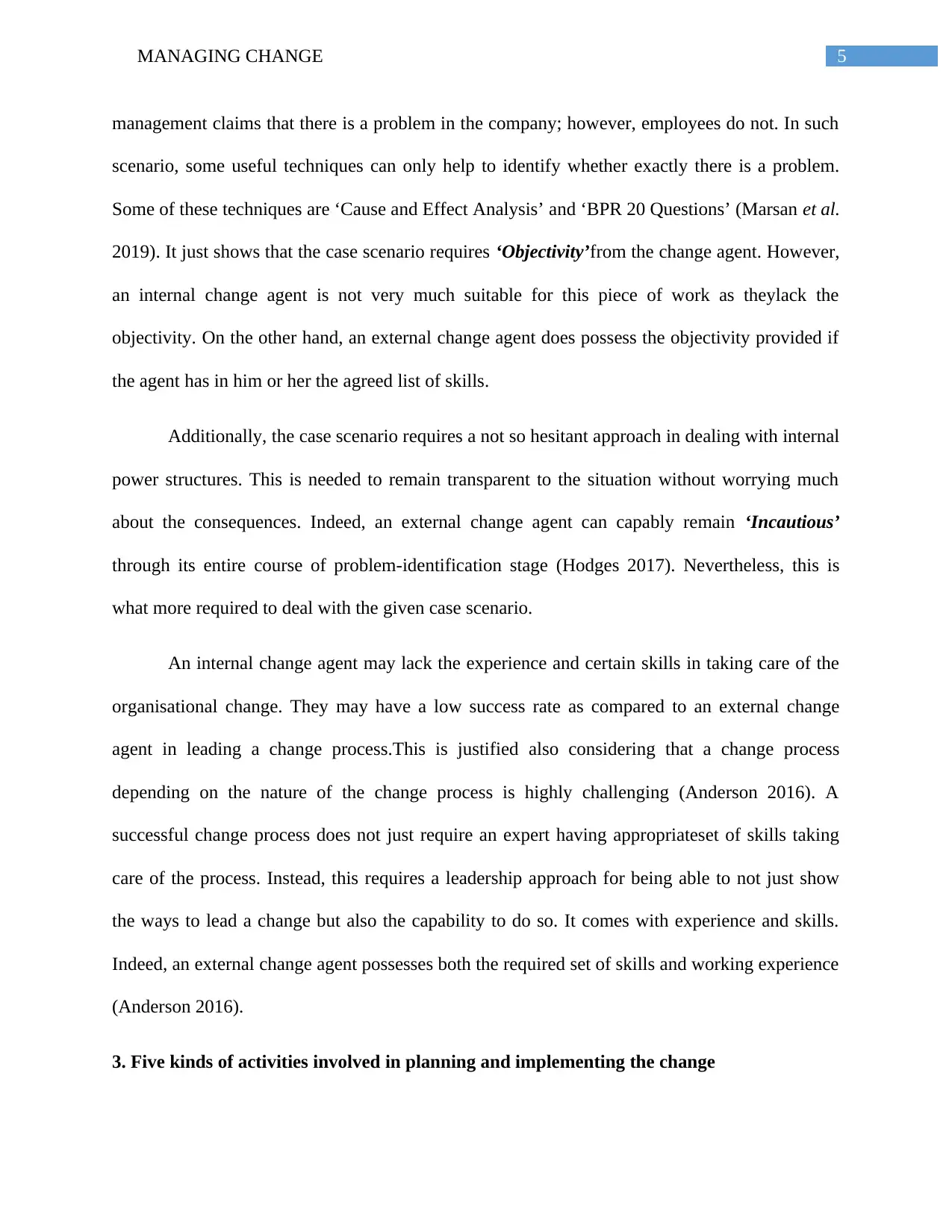
5MANAGING CHANGE
management claims that there is a problem in the company; however, employees do not. In such
scenario, some useful techniques can only help to identify whether exactly there is a problem.
Some of these techniques are ‘Cause and Effect Analysis’ and ‘BPR 20 Questions’ (Marsan et al.
2019). It just shows that the case scenario requires ‘Objectivity’from the change agent. However,
an internal change agent is not very much suitable for this piece of work as theylack the
objectivity. On the other hand, an external change agent does possess the objectivity provided if
the agent has in him or her the agreed list of skills.
Additionally, the case scenario requires a not so hesitant approach in dealing with internal
power structures. This is needed to remain transparent to the situation without worrying much
about the consequences. Indeed, an external change agent can capably remain ‘Incautious’
through its entire course of problem-identification stage (Hodges 2017). Nevertheless, this is
what more required to deal with the given case scenario.
An internal change agent may lack the experience and certain skills in taking care of the
organisational change. They may have a low success rate as compared to an external change
agent in leading a change process.This is justified also considering that a change process
depending on the nature of the change process is highly challenging (Anderson 2016). A
successful change process does not just require an expert having appropriateset of skills taking
care of the process. Instead, this requires a leadership approach for being able to not just show
the ways to lead a change but also the capability to do so. It comes with experience and skills.
Indeed, an external change agent possesses both the required set of skills and working experience
(Anderson 2016).
3. Five kinds of activities involved in planning and implementing the change
management claims that there is a problem in the company; however, employees do not. In such
scenario, some useful techniques can only help to identify whether exactly there is a problem.
Some of these techniques are ‘Cause and Effect Analysis’ and ‘BPR 20 Questions’ (Marsan et al.
2019). It just shows that the case scenario requires ‘Objectivity’from the change agent. However,
an internal change agent is not very much suitable for this piece of work as theylack the
objectivity. On the other hand, an external change agent does possess the objectivity provided if
the agent has in him or her the agreed list of skills.
Additionally, the case scenario requires a not so hesitant approach in dealing with internal
power structures. This is needed to remain transparent to the situation without worrying much
about the consequences. Indeed, an external change agent can capably remain ‘Incautious’
through its entire course of problem-identification stage (Hodges 2017). Nevertheless, this is
what more required to deal with the given case scenario.
An internal change agent may lack the experience and certain skills in taking care of the
organisational change. They may have a low success rate as compared to an external change
agent in leading a change process.This is justified also considering that a change process
depending on the nature of the change process is highly challenging (Anderson 2016). A
successful change process does not just require an expert having appropriateset of skills taking
care of the process. Instead, this requires a leadership approach for being able to not just show
the ways to lead a change but also the capability to do so. It comes with experience and skills.
Indeed, an external change agent possesses both the required set of skills and working experience
(Anderson 2016).
3. Five kinds of activities involved in planning and implementing the change
⊘ This is a preview!⊘
Do you want full access?
Subscribe today to unlock all pages.

Trusted by 1+ million students worldwide
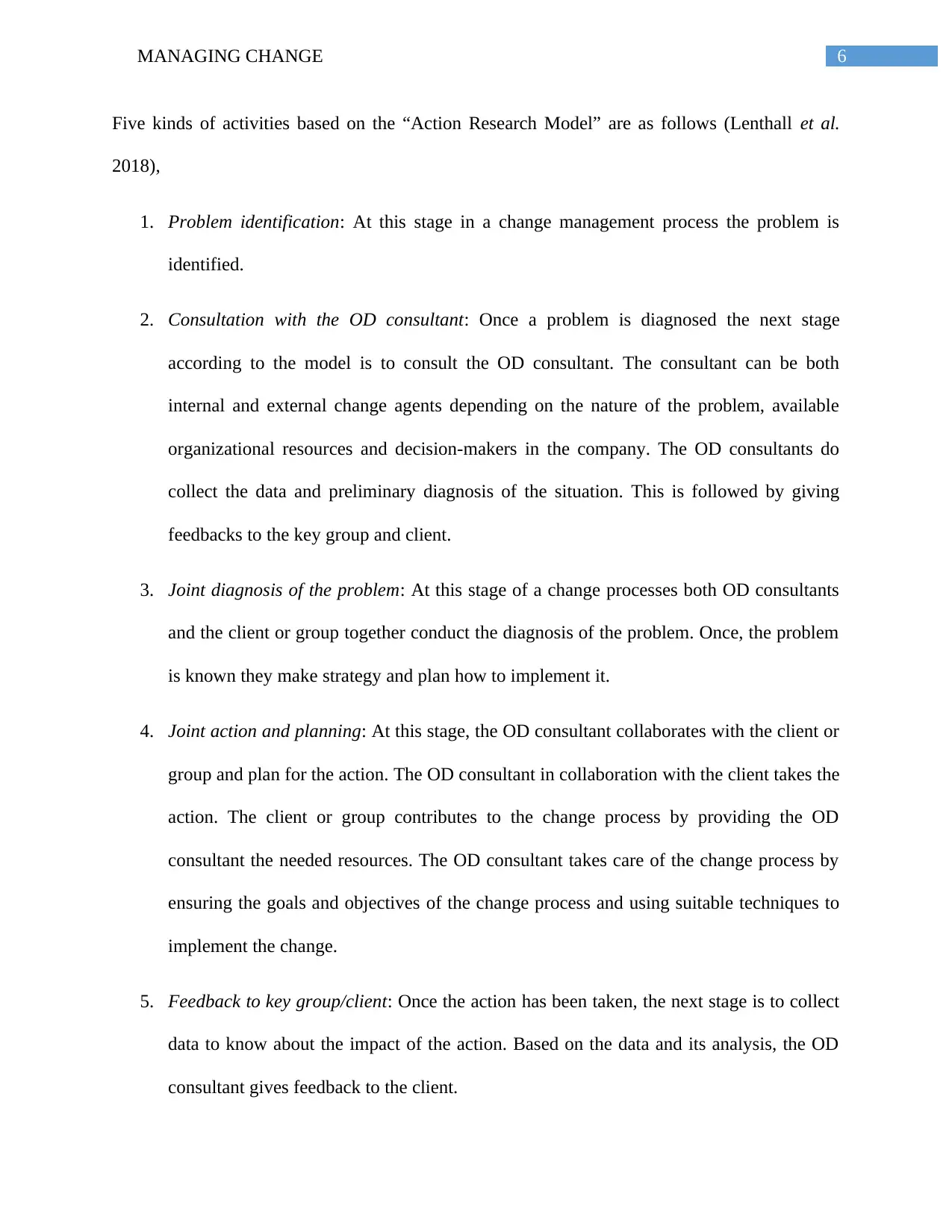
6MANAGING CHANGE
Five kinds of activities based on the “Action Research Model” are as follows (Lenthall et al.
2018),
1. Problem identification: At this stage in a change management process the problem is
identified.
2. Consultation with the OD consultant: Once a problem is diagnosed the next stage
according to the model is to consult the OD consultant. The consultant can be both
internal and external change agents depending on the nature of the problem, available
organizational resources and decision-makers in the company. The OD consultants do
collect the data and preliminary diagnosis of the situation. This is followed by giving
feedbacks to the key group and client.
3. Joint diagnosis of the problem: At this stage of a change processes both OD consultants
and the client or group together conduct the diagnosis of the problem. Once, the problem
is known they make strategy and plan how to implement it.
4. Joint action and planning: At this stage, the OD consultant collaborates with the client or
group and plan for the action. The OD consultant in collaboration with the client takes the
action. The client or group contributes to the change process by providing the OD
consultant the needed resources. The OD consultant takes care of the change process by
ensuring the goals and objectives of the change process and using suitable techniques to
implement the change.
5. Feedback to key group/client: Once the action has been taken, the next stage is to collect
data to know about the impact of the action. Based on the data and its analysis, the OD
consultant gives feedback to the client.
Five kinds of activities based on the “Action Research Model” are as follows (Lenthall et al.
2018),
1. Problem identification: At this stage in a change management process the problem is
identified.
2. Consultation with the OD consultant: Once a problem is diagnosed the next stage
according to the model is to consult the OD consultant. The consultant can be both
internal and external change agents depending on the nature of the problem, available
organizational resources and decision-makers in the company. The OD consultants do
collect the data and preliminary diagnosis of the situation. This is followed by giving
feedbacks to the key group and client.
3. Joint diagnosis of the problem: At this stage of a change processes both OD consultants
and the client or group together conduct the diagnosis of the problem. Once, the problem
is known they make strategy and plan how to implement it.
4. Joint action and planning: At this stage, the OD consultant collaborates with the client or
group and plan for the action. The OD consultant in collaboration with the client takes the
action. The client or group contributes to the change process by providing the OD
consultant the needed resources. The OD consultant takes care of the change process by
ensuring the goals and objectives of the change process and using suitable techniques to
implement the change.
5. Feedback to key group/client: Once the action has been taken, the next stage is to collect
data to know about the impact of the action. Based on the data and its analysis, the OD
consultant gives feedback to the client.
Paraphrase This Document
Need a fresh take? Get an instant paraphrase of this document with our AI Paraphraser
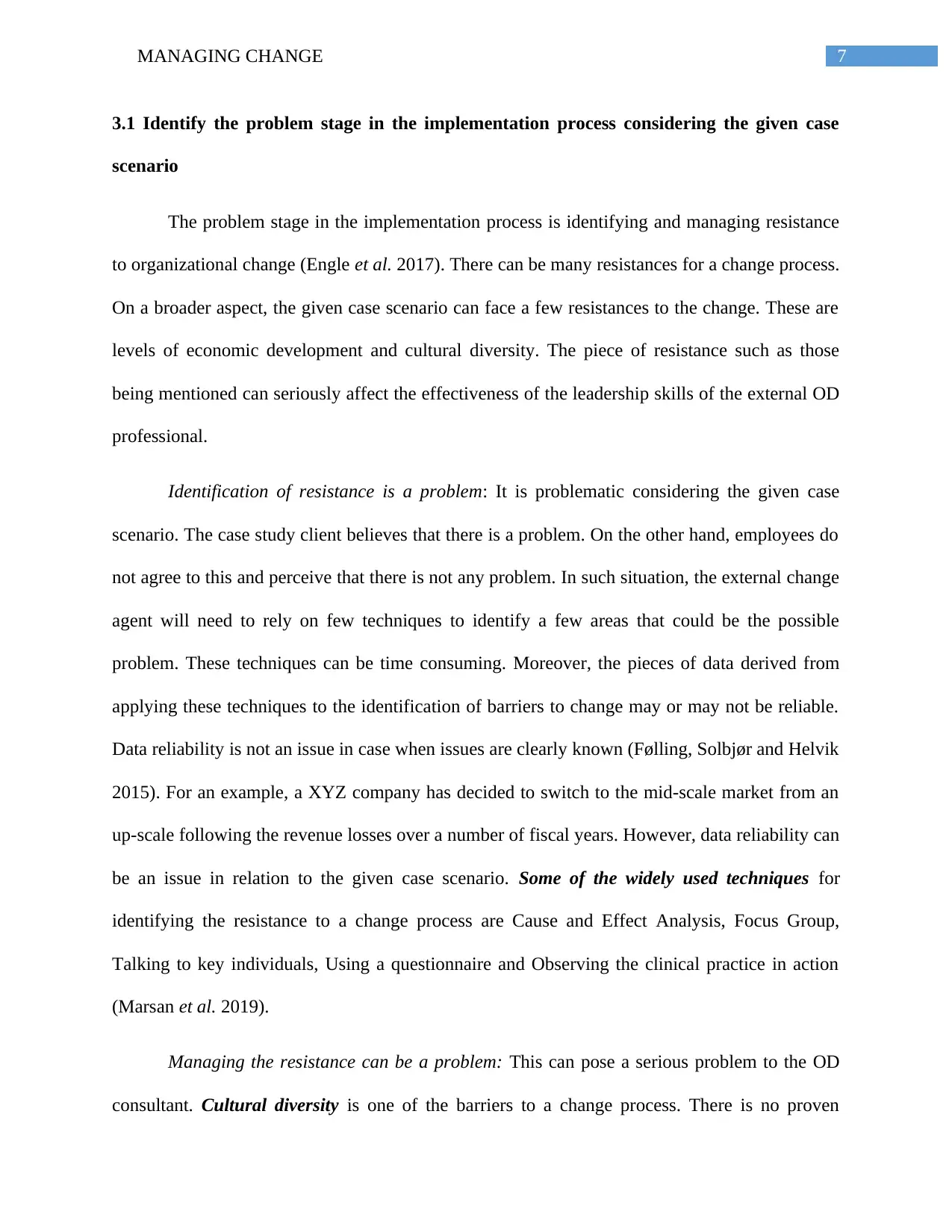
7MANAGING CHANGE
3.1 Identify the problem stage in the implementation process considering the given case
scenario
The problem stage in the implementation process is identifying and managing resistance
to organizational change (Engle et al. 2017). There can be many resistances for a change process.
On a broader aspect, the given case scenario can face a few resistances to the change. These are
levels of economic development and cultural diversity. The piece of resistance such as those
being mentioned can seriously affect the effectiveness of the leadership skills of the external OD
professional.
Identification of resistance is a problem: It is problematic considering the given case
scenario. The case study client believes that there is a problem. On the other hand, employees do
not agree to this and perceive that there is not any problem. In such situation, the external change
agent will need to rely on few techniques to identify a few areas that could be the possible
problem. These techniques can be time consuming. Moreover, the pieces of data derived from
applying these techniques to the identification of barriers to change may or may not be reliable.
Data reliability is not an issue in case when issues are clearly known (Følling, Solbjør and Helvik
2015). For an example, a XYZ company has decided to switch to the mid-scale market from an
up-scale following the revenue losses over a number of fiscal years. However, data reliability can
be an issue in relation to the given case scenario. Some of the widely used techniques for
identifying the resistance to a change process are Cause and Effect Analysis, Focus Group,
Talking to key individuals, Using a questionnaire and Observing the clinical practice in action
(Marsan et al. 2019).
Managing the resistance can be a problem: This can pose a serious problem to the OD
consultant. Cultural diversity is one of the barriers to a change process. There is no proven
3.1 Identify the problem stage in the implementation process considering the given case
scenario
The problem stage in the implementation process is identifying and managing resistance
to organizational change (Engle et al. 2017). There can be many resistances for a change process.
On a broader aspect, the given case scenario can face a few resistances to the change. These are
levels of economic development and cultural diversity. The piece of resistance such as those
being mentioned can seriously affect the effectiveness of the leadership skills of the external OD
professional.
Identification of resistance is a problem: It is problematic considering the given case
scenario. The case study client believes that there is a problem. On the other hand, employees do
not agree to this and perceive that there is not any problem. In such situation, the external change
agent will need to rely on few techniques to identify a few areas that could be the possible
problem. These techniques can be time consuming. Moreover, the pieces of data derived from
applying these techniques to the identification of barriers to change may or may not be reliable.
Data reliability is not an issue in case when issues are clearly known (Følling, Solbjør and Helvik
2015). For an example, a XYZ company has decided to switch to the mid-scale market from an
up-scale following the revenue losses over a number of fiscal years. However, data reliability can
be an issue in relation to the given case scenario. Some of the widely used techniques for
identifying the resistance to a change process are Cause and Effect Analysis, Focus Group,
Talking to key individuals, Using a questionnaire and Observing the clinical practice in action
(Marsan et al. 2019).
Managing the resistance can be a problem: This can pose a serious problem to the OD
consultant. Cultural diversity is one of the barriers to a change process. There is no proven
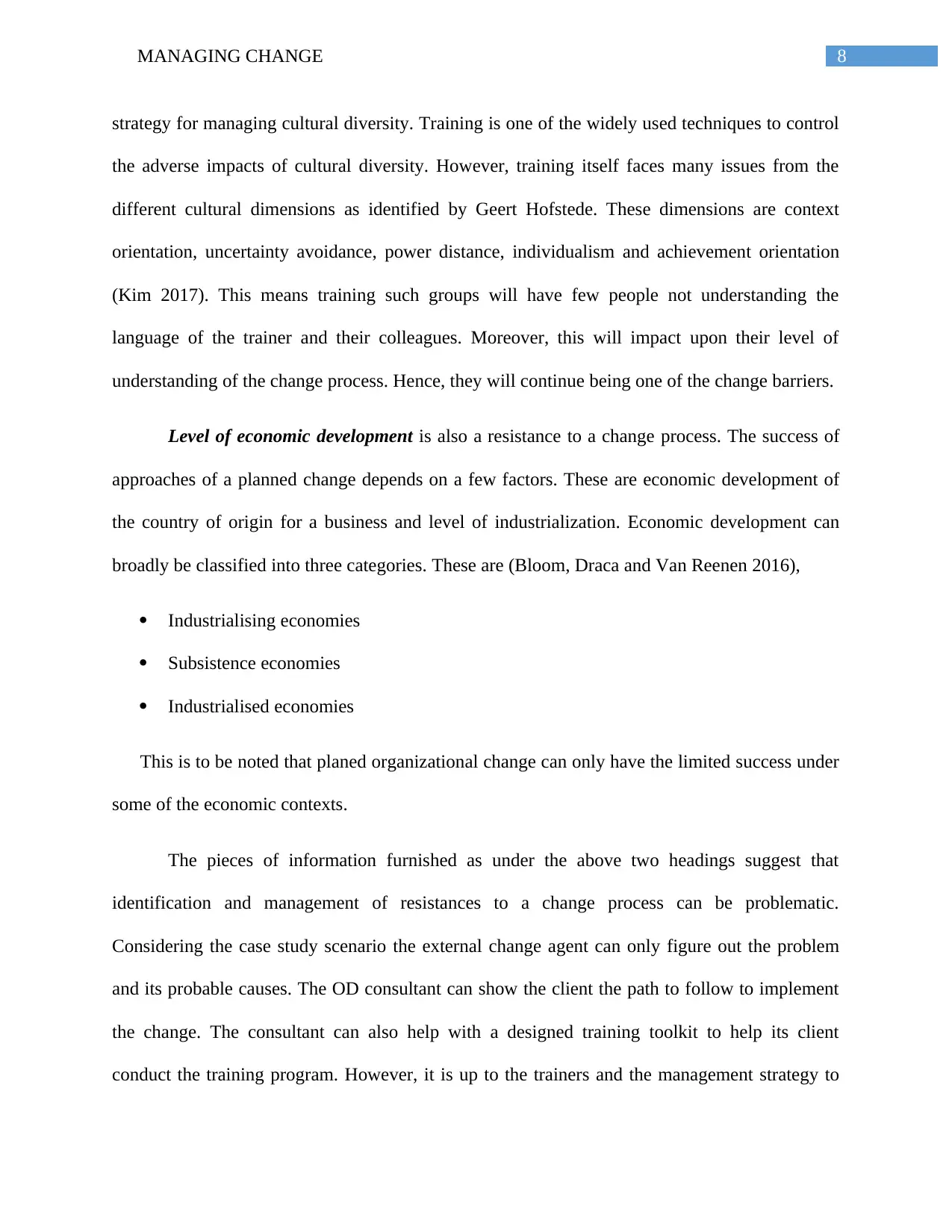
8MANAGING CHANGE
strategy for managing cultural diversity. Training is one of the widely used techniques to control
the adverse impacts of cultural diversity. However, training itself faces many issues from the
different cultural dimensions as identified by Geert Hofstede. These dimensions are context
orientation, uncertainty avoidance, power distance, individualism and achievement orientation
(Kim 2017). This means training such groups will have few people not understanding the
language of the trainer and their colleagues. Moreover, this will impact upon their level of
understanding of the change process. Hence, they will continue being one of the change barriers.
Level of economic development is also a resistance to a change process. The success of
approaches of a planned change depends on a few factors. These are economic development of
the country of origin for a business and level of industrialization. Economic development can
broadly be classified into three categories. These are (Bloom, Draca and Van Reenen 2016),
Industrialising economies
Subsistence economies
Industrialised economies
This is to be noted that planed organizational change can only have the limited success under
some of the economic contexts.
The pieces of information furnished as under the above two headings suggest that
identification and management of resistances to a change process can be problematic.
Considering the case study scenario the external change agent can only figure out the problem
and its probable causes. The OD consultant can show the client the path to follow to implement
the change. The consultant can also help with a designed training toolkit to help its client
conduct the training program. However, it is up to the trainers and the management strategy to
strategy for managing cultural diversity. Training is one of the widely used techniques to control
the adverse impacts of cultural diversity. However, training itself faces many issues from the
different cultural dimensions as identified by Geert Hofstede. These dimensions are context
orientation, uncertainty avoidance, power distance, individualism and achievement orientation
(Kim 2017). This means training such groups will have few people not understanding the
language of the trainer and their colleagues. Moreover, this will impact upon their level of
understanding of the change process. Hence, they will continue being one of the change barriers.
Level of economic development is also a resistance to a change process. The success of
approaches of a planned change depends on a few factors. These are economic development of
the country of origin for a business and level of industrialization. Economic development can
broadly be classified into three categories. These are (Bloom, Draca and Van Reenen 2016),
Industrialising economies
Subsistence economies
Industrialised economies
This is to be noted that planed organizational change can only have the limited success under
some of the economic contexts.
The pieces of information furnished as under the above two headings suggest that
identification and management of resistances to a change process can be problematic.
Considering the case study scenario the external change agent can only figure out the problem
and its probable causes. The OD consultant can show the client the path to follow to implement
the change. The consultant can also help with a designed training toolkit to help its client
conduct the training program. However, it is up to the trainers and the management strategy to
⊘ This is a preview!⊘
Do you want full access?
Subscribe today to unlock all pages.

Trusted by 1+ million students worldwide
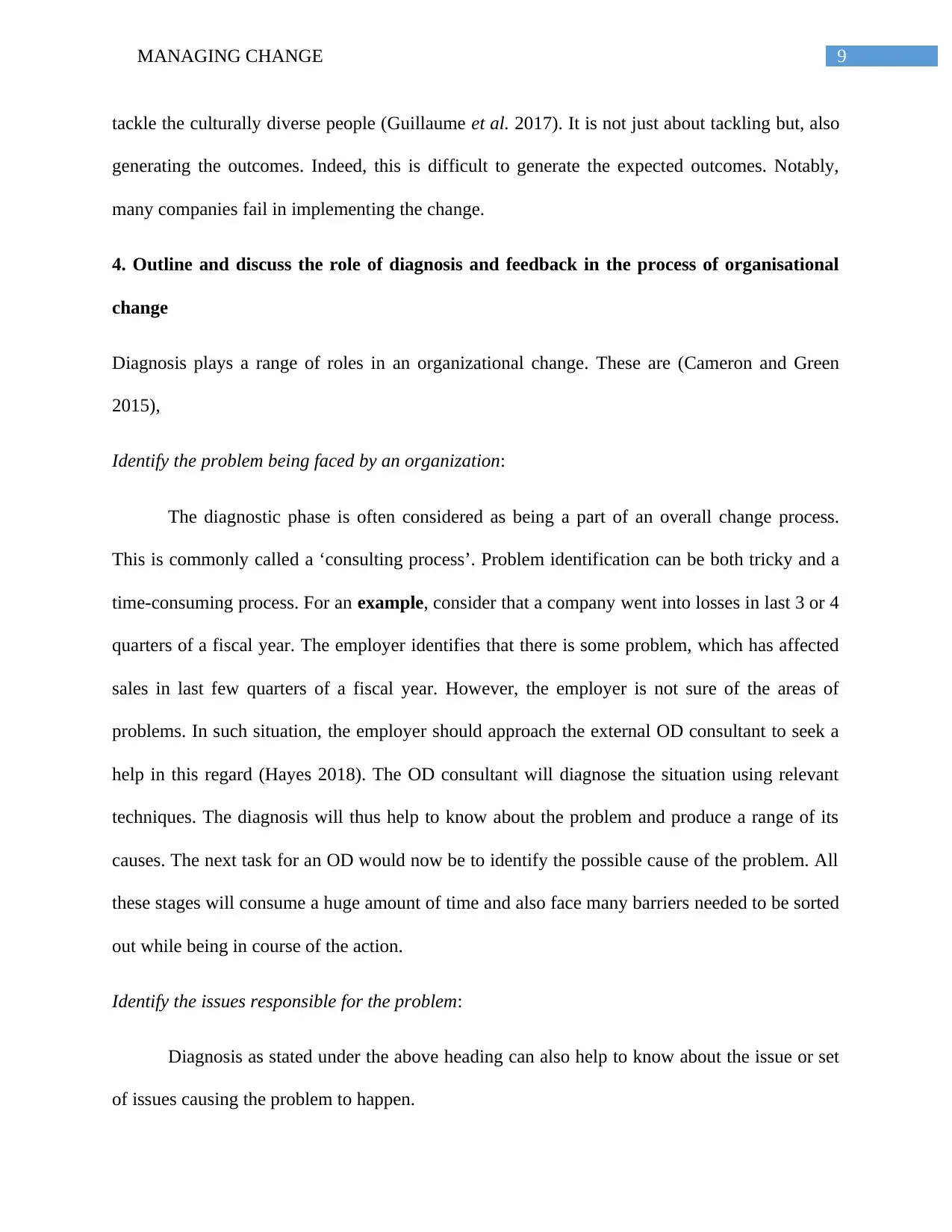
9MANAGING CHANGE
tackle the culturally diverse people (Guillaume et al. 2017). It is not just about tackling but, also
generating the outcomes. Indeed, this is difficult to generate the expected outcomes. Notably,
many companies fail in implementing the change.
4. Outline and discuss the role of diagnosis and feedback in the process of organisational
change
Diagnosis plays a range of roles in an organizational change. These are (Cameron and Green
2015),
Identify the problem being faced by an organization:
The diagnostic phase is often considered as being a part of an overall change process.
This is commonly called a ‘consulting process’. Problem identification can be both tricky and a
time-consuming process. For an example, consider that a company went into losses in last 3 or 4
quarters of a fiscal year. The employer identifies that there is some problem, which has affected
sales in last few quarters of a fiscal year. However, the employer is not sure of the areas of
problems. In such situation, the employer should approach the external OD consultant to seek a
help in this regard (Hayes 2018). The OD consultant will diagnose the situation using relevant
techniques. The diagnosis will thus help to know about the problem and produce a range of its
causes. The next task for an OD would now be to identify the possible cause of the problem. All
these stages will consume a huge amount of time and also face many barriers needed to be sorted
out while being in course of the action.
Identify the issues responsible for the problem:
Diagnosis as stated under the above heading can also help to know about the issue or set
of issues causing the problem to happen.
tackle the culturally diverse people (Guillaume et al. 2017). It is not just about tackling but, also
generating the outcomes. Indeed, this is difficult to generate the expected outcomes. Notably,
many companies fail in implementing the change.
4. Outline and discuss the role of diagnosis and feedback in the process of organisational
change
Diagnosis plays a range of roles in an organizational change. These are (Cameron and Green
2015),
Identify the problem being faced by an organization:
The diagnostic phase is often considered as being a part of an overall change process.
This is commonly called a ‘consulting process’. Problem identification can be both tricky and a
time-consuming process. For an example, consider that a company went into losses in last 3 or 4
quarters of a fiscal year. The employer identifies that there is some problem, which has affected
sales in last few quarters of a fiscal year. However, the employer is not sure of the areas of
problems. In such situation, the employer should approach the external OD consultant to seek a
help in this regard (Hayes 2018). The OD consultant will diagnose the situation using relevant
techniques. The diagnosis will thus help to know about the problem and produce a range of its
causes. The next task for an OD would now be to identify the possible cause of the problem. All
these stages will consume a huge amount of time and also face many barriers needed to be sorted
out while being in course of the action.
Identify the issues responsible for the problem:
Diagnosis as stated under the above heading can also help to know about the issue or set
of issues causing the problem to happen.
Paraphrase This Document
Need a fresh take? Get an instant paraphrase of this document with our AI Paraphraser
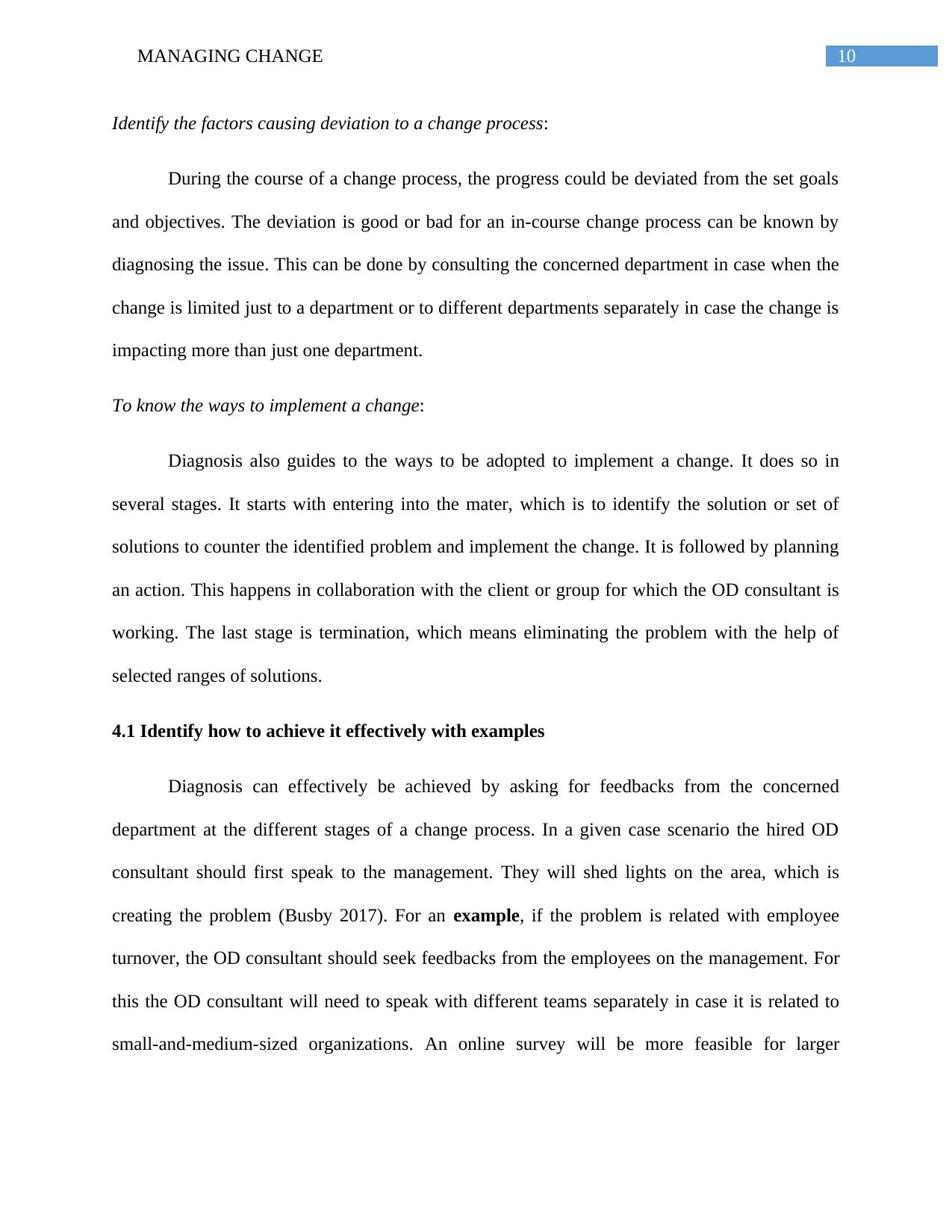
10MANAGING CHANGE
Identify the factors causing deviation to a change process:
During the course of a change process, the progress could be deviated from the set goals
and objectives. The deviation is good or bad for an in-course change process can be known by
diagnosing the issue. This can be done by consulting the concerned department in case when the
change is limited just to a department or to different departments separately in case the change is
impacting more than just one department.
To know the ways to implement a change:
Diagnosis also guides to the ways to be adopted to implement a change. It does so in
several stages. It starts with entering into the mater, which is to identify the solution or set of
solutions to counter the identified problem and implement the change. It is followed by planning
an action. This happens in collaboration with the client or group for which the OD consultant is
working. The last stage is termination, which means eliminating the problem with the help of
selected ranges of solutions.
4.1 Identify how to achieve it effectively with examples
Diagnosis can effectively be achieved by asking for feedbacks from the concerned
department at the different stages of a change process. In a given case scenario the hired OD
consultant should first speak to the management. They will shed lights on the area, which is
creating the problem (Busby 2017). For an example, if the problem is related with employee
turnover, the OD consultant should seek feedbacks from the employees on the management. For
this the OD consultant will need to speak with different teams separately in case it is related to
small-and-medium-sized organizations. An online survey will be more feasible for larger
Identify the factors causing deviation to a change process:
During the course of a change process, the progress could be deviated from the set goals
and objectives. The deviation is good or bad for an in-course change process can be known by
diagnosing the issue. This can be done by consulting the concerned department in case when the
change is limited just to a department or to different departments separately in case the change is
impacting more than just one department.
To know the ways to implement a change:
Diagnosis also guides to the ways to be adopted to implement a change. It does so in
several stages. It starts with entering into the mater, which is to identify the solution or set of
solutions to counter the identified problem and implement the change. It is followed by planning
an action. This happens in collaboration with the client or group for which the OD consultant is
working. The last stage is termination, which means eliminating the problem with the help of
selected ranges of solutions.
4.1 Identify how to achieve it effectively with examples
Diagnosis can effectively be achieved by asking for feedbacks from the concerned
department at the different stages of a change process. In a given case scenario the hired OD
consultant should first speak to the management. They will shed lights on the area, which is
creating the problem (Busby 2017). For an example, if the problem is related with employee
turnover, the OD consultant should seek feedbacks from the employees on the management. For
this the OD consultant will need to speak with different teams separately in case it is related to
small-and-medium-sized organizations. An online survey will be more feasible for larger
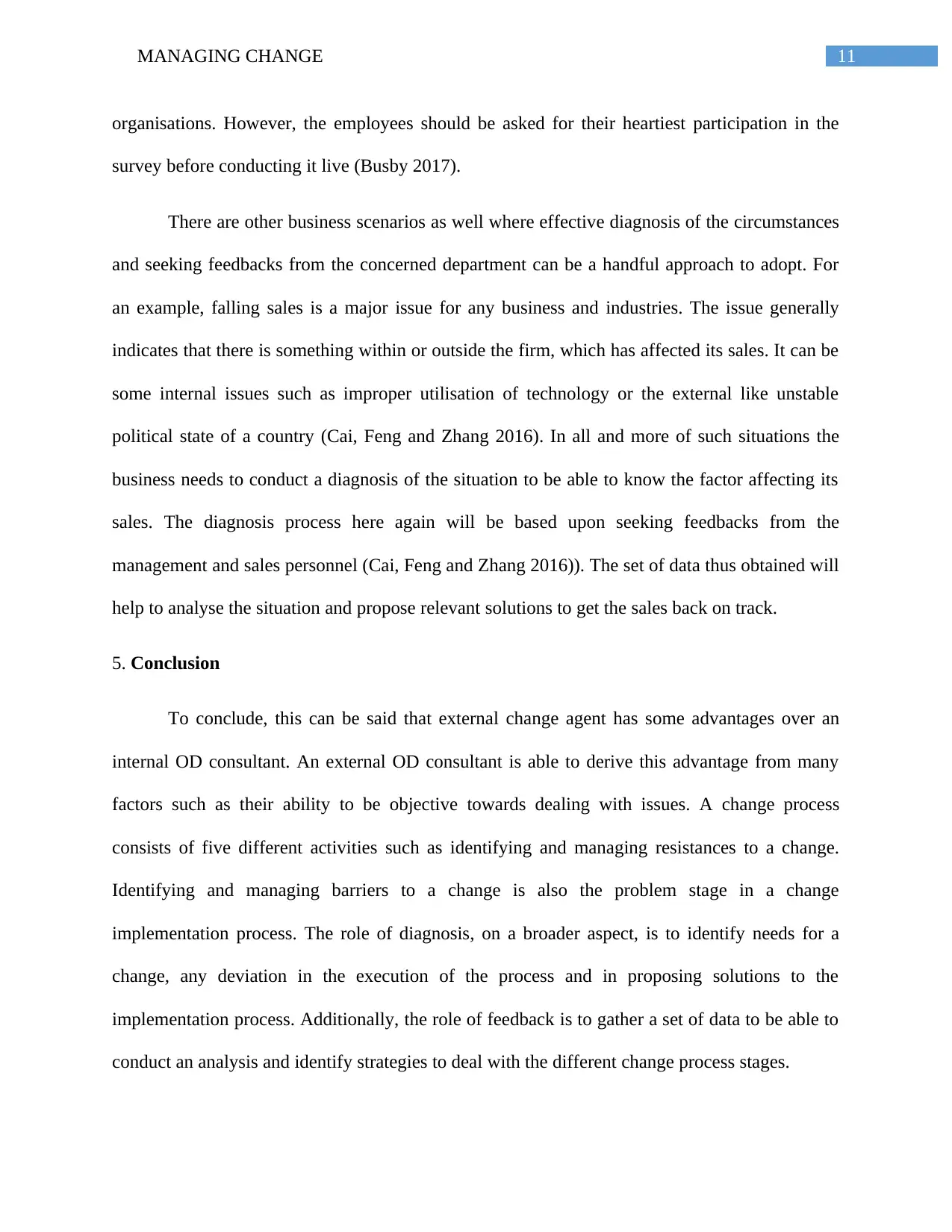
11MANAGING CHANGE
organisations. However, the employees should be asked for their heartiest participation in the
survey before conducting it live (Busby 2017).
There are other business scenarios as well where effective diagnosis of the circumstances
and seeking feedbacks from the concerned department can be a handful approach to adopt. For
an example, falling sales is a major issue for any business and industries. The issue generally
indicates that there is something within or outside the firm, which has affected its sales. It can be
some internal issues such as improper utilisation of technology or the external like unstable
political state of a country (Cai, Feng and Zhang 2016). In all and more of such situations the
business needs to conduct a diagnosis of the situation to be able to know the factor affecting its
sales. The diagnosis process here again will be based upon seeking feedbacks from the
management and sales personnel (Cai, Feng and Zhang 2016)). The set of data thus obtained will
help to analyse the situation and propose relevant solutions to get the sales back on track.
5. Conclusion
To conclude, this can be said that external change agent has some advantages over an
internal OD consultant. An external OD consultant is able to derive this advantage from many
factors such as their ability to be objective towards dealing with issues. A change process
consists of five different activities such as identifying and managing resistances to a change.
Identifying and managing barriers to a change is also the problem stage in a change
implementation process. The role of diagnosis, on a broader aspect, is to identify needs for a
change, any deviation in the execution of the process and in proposing solutions to the
implementation process. Additionally, the role of feedback is to gather a set of data to be able to
conduct an analysis and identify strategies to deal with the different change process stages.
organisations. However, the employees should be asked for their heartiest participation in the
survey before conducting it live (Busby 2017).
There are other business scenarios as well where effective diagnosis of the circumstances
and seeking feedbacks from the concerned department can be a handful approach to adopt. For
an example, falling sales is a major issue for any business and industries. The issue generally
indicates that there is something within or outside the firm, which has affected its sales. It can be
some internal issues such as improper utilisation of technology or the external like unstable
political state of a country (Cai, Feng and Zhang 2016). In all and more of such situations the
business needs to conduct a diagnosis of the situation to be able to know the factor affecting its
sales. The diagnosis process here again will be based upon seeking feedbacks from the
management and sales personnel (Cai, Feng and Zhang 2016)). The set of data thus obtained will
help to analyse the situation and propose relevant solutions to get the sales back on track.
5. Conclusion
To conclude, this can be said that external change agent has some advantages over an
internal OD consultant. An external OD consultant is able to derive this advantage from many
factors such as their ability to be objective towards dealing with issues. A change process
consists of five different activities such as identifying and managing resistances to a change.
Identifying and managing barriers to a change is also the problem stage in a change
implementation process. The role of diagnosis, on a broader aspect, is to identify needs for a
change, any deviation in the execution of the process and in proposing solutions to the
implementation process. Additionally, the role of feedback is to gather a set of data to be able to
conduct an analysis and identify strategies to deal with the different change process stages.
⊘ This is a preview!⊘
Do you want full access?
Subscribe today to unlock all pages.

Trusted by 1+ million students worldwide
1 out of 15
Related Documents
Your All-in-One AI-Powered Toolkit for Academic Success.
+13062052269
info@desklib.com
Available 24*7 on WhatsApp / Email
![[object Object]](/_next/static/media/star-bottom.7253800d.svg)
Unlock your academic potential
Copyright © 2020–2025 A2Z Services. All Rights Reserved. Developed and managed by ZUCOL.





